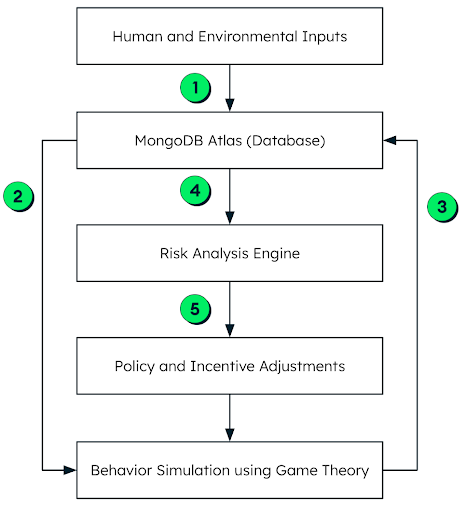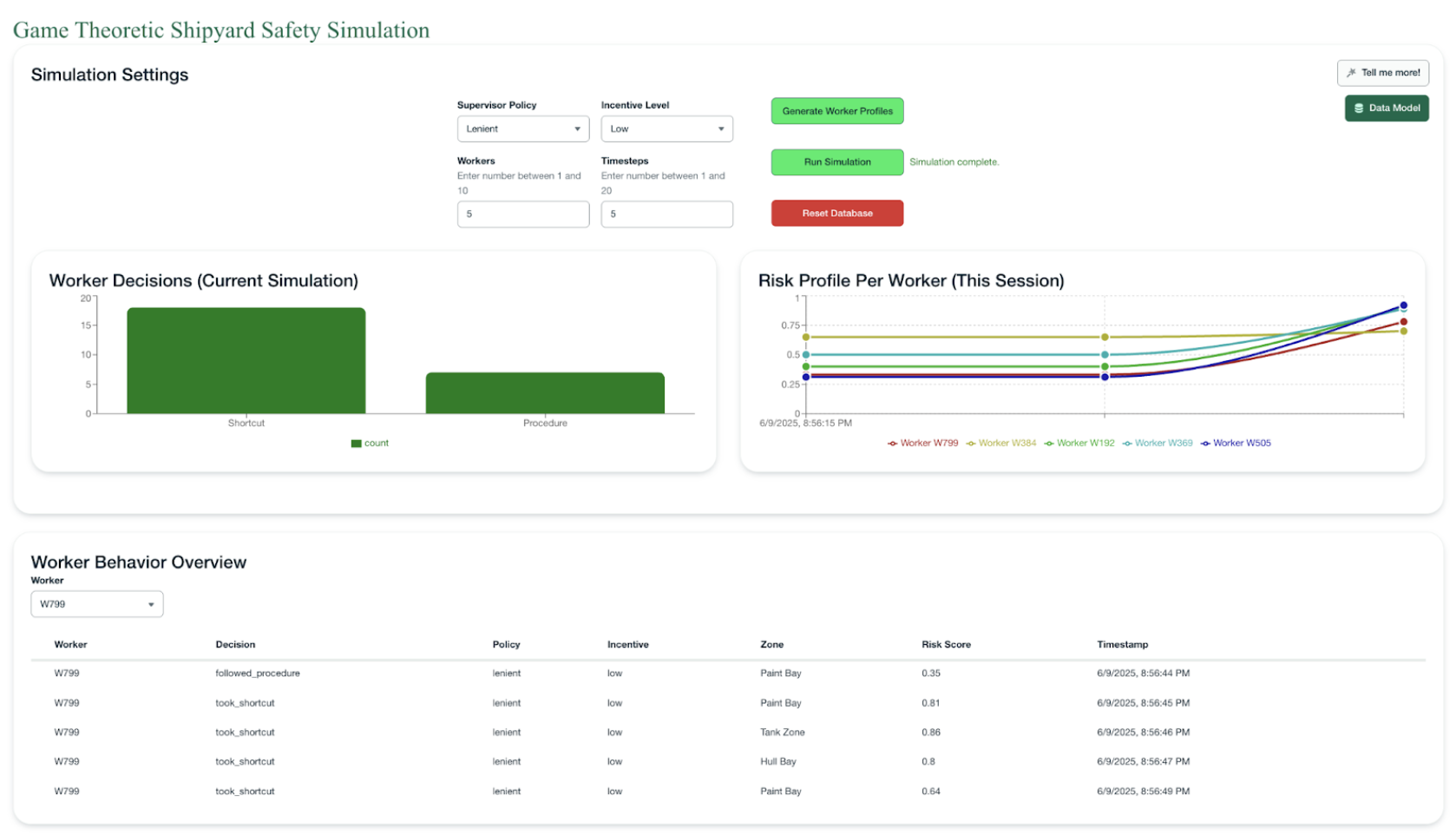Improving Industrial Safety with Game Theory and MongoDB
In industrial operations, safety is both a business and a human imperative. Heavy-asset industries like aerospace, shipbuilding, and construction constantly invest in better safety systems and policies to keep their staff safe. But a variety of factors—tight physical environments, time pressures, and steep production targets—can lead workers to take unsafe shortcuts to meet quotas. For instance, the European Maritime Safety Agency (EMSA) cited 650 fatalities and over 7,600 injuries linked to marine incidents involving EU-registered ships between 2014 and 2023, and human factors contributed to 80% of these incidents.
Traditional safety incident reporting tools focus on retrospective data. Such systems capture and document safety incidents only after they have occurred, meaning that companies are reacting to events rather than proactively preventing them. On the ground, factory and shipyard workers often find themselves having to make split-second choices: safety versus speed, following protocols versus meeting production targets, etc. To move beyond hindsight—and to proactively guarantee safety—organizations must be able to model and analyze these behavioral trade-offs in real time to build informed policy (as well as an organizational culture) that supports safe behavior on the ground.
In this blog post, we’ll dive into how organizations can leverage MongoDB as a unified operational data store for time series sensor telemetry, worker decisions, and contextual factors. By consolidating this information into a single database, MongoDB makes it possible to easily generate proactive insights into how workers will act under different conditions, thereby improving safety policies and incentives.
Modeling human decisions and trade-offs in industrial environments
Game theory, a mathematical framework used to model and analyze strategic interactions between individuals or entities, can be leveraged here to better anticipate and influence operational decisions. Let’s use the example of a shipyard, in which workers must constantly weigh critical decisions—balancing safety against speed, following rules versus meeting deadlines, deciding whether to take a shortcut that helps them hit a deadline. These decisions are not random and are shaped by peer pressures, working conditions, management oversight, and the incentive structures in place. So in an industrial context, game theory allows us to simulate these decisions as an ongoing, repeated game. For example, “if a policy is too strict, do workers take more risks to save time?” or “if incentives favor speed, does safety compliance drop?” and most importantly, “how do these patterns evolve as conditions and oversight change?”
By modeling these decisions and choices as part of a repeated game, we can simulate how workers behave under different combinations of policy strictness and incentive strength.
To create such a game-theoretic system, we need to bring together different data sets—real-time environmental sensor telemetry, worker profiles, operations context, etc.—and use this data to simulate a game-theoretic model. A behavior-aware safety simulation engine powered by MongoDB enables this approach; the engine brings together disparate data and models it using MongoDB’s flexible document model. The document model can easily adapt to the fast-changing, real-time conditions, meaning that companies can leverage MongoDB to build data-driven and dynamic safety policy tuning systems in order to predict where, when, and why risky behavior might occur during daily operations.
MongoDB Atlas: Turning game theory into industrial intelligence
To bring this model to life, we need to simulate, store, and analyze decision flows in real time. This is where MongoDB Atlas plays a central role. In this example, we will build this solution for shipyard operations.
Figure 1 shows the conceptual architecture of our simulation engine, in which MongoDB acts as both the behavioral memory and analytical core, capturing decisions, scoring risk, and enabling feedback-driven policy experimentation.

Per below, we can see the figure’s architecture definition of each element that drives smarter decision-making with smarter outcomes for a seamless, real-time integration:
-
Time series data storage: All worker actions/decisions and sensor (temperature, gas, humidity, etc.) data are stored in MongoDB collections as a central, flexible operational database.
-
Game theoretic decision modeling: A game theory-based simulator models worker trade-offs under different policy and incentive setups.
-
Data contextualization and storage: MongoDB stores not just the raw sensor data but context as well, which includes payoff and risk. Flexibility of the document model enables easy data modelling.
-
Risk scoring and analysis: MongoDB’s Aggregation Framework helps analyze trends over time to detect rising risk profiles or policy blind spots.
-
Adaptive safety design: Safety teams can tweak policies and incentives directly, shaping safer behavior before incidents occur.
MongoDB acts as the data backbone for the entire solution, storing three key datasets; the code snippets below show a detailed document model visibility per collection in Atlas:
Environmental telemetry (sensor_data time series collection) from simulated or actual sensors in the shipyard:
{
 "timestamp": {
 "$date": "2025-06-06T20:00:22.970Z"
 },
 "zone": "Tank Zone",
 "run_id": "9722c0e7-c10d-4526-a1a1-2647c9731589",
 "_id": {
 "$oid": "684348d687d59464d1f498d0"
 },
 "temperature": 42.6,
 "gas": "normal"
}
Worker profiles (workers collection) capturing static attributes and evolving risk indicators:
{
 "timestamp": "2025-04-15T01:57:04.938Z",
 "workerId": "W539",
 "zone": "Tank Zone",
 "environment": {
 "temperature": 35.3,
 "gas": "normal"
 },
 "incentive": "high",
 "decision": "followed_procedure",
 "policy": "strict",
 "computed": {
 "risk_score": 0.24,
 "payoff": 3
 },
 "_id": {
 "$oid": "67fdbcf0b9b3624b42add7b4"
 }
}
Behavior logs (worker_behavior time series collection) recording every simulated or real decision made in context (policy, incentive, zone):
{
 "_id": "W539",
 "name": "Worker89",
 "role": "Welder",
 "risk_profile": {
 "avg_shortcut_rate": 0,
 "historical_decision_trends": [
 {
 "policy": "strict",
 "incentive": "high",
 "rate": 0
 }
 ]
 },
 "metadata": {
 "ppe_compliance": "good",
 "training_completed": [
 "confined space",
 "hazmat"
 ]
 }
}
Figure 2, meanwhile, shows the physical architecture of the behavior-aware simulation system. Here, MongoDB acts as the central data backbone, providing data to the risk and decision dashboard for trend analysis and policy experimentation.

MongoDB provides all the foundational building blocks to power our simulation engine from end to end. The time series collections enable high-speed ingestion of sensor data while built-in compression and windowing functions support efficient risk scoring and trend analysis at scale. This eliminates the need for an external time series database. Change streams and Atlas Stream Processing power real-time dashboards and risk analytics pipelines that respond to new inputs as they occur.
As policies, sensors, or simulator logic evolve over time, MongoDB’s flexible schema ensures that you do not need to rework your data model or incur any downtime. Finally, Atlas Vector Search can help derive insights from unstructured text data such as incident reports or operator feedback.
Figure 3 shows the solution in action; over time, the risk profiles of simulated workers rise because of the policy leniency and low incentive levels. The figure highlights how even well-meaning safety policies can unintentionally encourage risky behavior and even workplace accidents—which is why it’s critical to simulate and evaluate policies’ impact before deploying them in the real world.

With these safety insights stored and analyzed in MongoDB, organizations can run what-if scenarios, adjust policy configurations, and measure predicted behavioral outcomes in advance.
The organizational impact of such a system is significant because safety leaders can move away from reactive investigations to proactive policy design. For example, a shipyard might decide to introduce targeted safety training for specific zones, or fine-tune supervision protocols based on the simulation outcomes, rather than waiting for an actual incident to occur.
Together, these features make MongoDB uniquely suited to drive safety innovation where real-world complexity demands flexible and scalable infrastructure.
Check out the repo of this solution that you can clone and try out yourself. To learn more about MongoDB’s role in the manufacturing industry, please visit our manufacturing and automotive page.
This article first appeared on Read More

